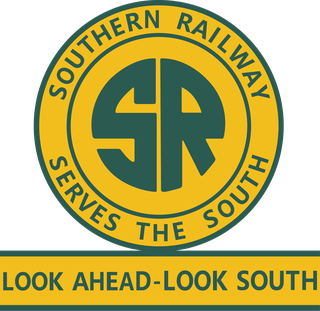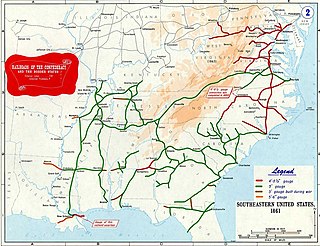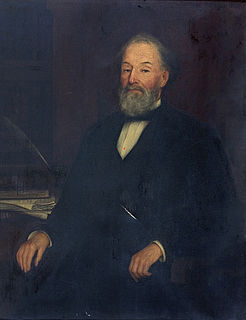Related Research Articles

The Interstate Commerce Commission (ICC) was a regulatory agency in the United States created by the Interstate Commerce Act of 1887. The agency's original purpose was to regulate railroads to ensure fair rates, to eliminate rate discrimination, and to regulate other aspects of common carriers, including interstate bus lines and telephone companies. Congress expanded ICC authority to regulate other modes of commerce beginning in 1906. Throughout the 20th century several of ICC's authorities were transferred to other federal agencies. The ICC was abolished in 1995, and its remaining functions were transferred to the Surface Transportation Board.

The Baltimore and Ohio Railroad was the first common carrier railroad and the oldest railroad in the United States, with its first section opening in 1830. Merchants from the city of Baltimore, which had benefitted to some extent from the construction of the National Road early in the century, wanted to continue to compete for trade with trans-Appalachian settlers with the newly constructed Erie Canal, another canal being proposed by Pennsylvania, the Chesapeake and Ohio Canal, and the James River Canal, which directed traffic toward Richmond and Norfolk, Virginia. At first the B&O was located entirely in the state of Maryland, its original line extending from the port of Baltimore west to Sandy Hook. There it connected with Harper's Ferry across the Potomac into Virginia, and also with the navegable Shenandoah River.

The Crescent is a daily long-distance passenger train operated by Amtrak in the eastern United States. It operates 1,377 miles (2,216 km) daily between Pennsylvania Station in New York City and Union Passenger Terminal in New Orleans as train numbers 19 and 20. Major service stops outside the Northeast Corridor include Birmingham, Alabama, Atlanta, Georgia and Charlotte, North Carolina.

Benjamin Franklin Butler was a major general of the Union Army, politician, lawyer and businessman from Massachusetts. Born in New Hampshire and raised in Lowell, Massachusetts, Butler is best known as a political major general of the Union Army during the American Civil War, and for his leadership role in the impeachment of U.S. President Andrew Johnson. He was a colorful and often controversial figure on the national stage and in the Massachusetts political scene and ran several campaigns for Governor before his election to that office in 1882.

The Norfolk and Western Railway was a US class I railroad, formed by more than 200 railroad mergers between 1838 and 1982. It was headquartered in Roanoke, Virginia, for most of its existence. Its motto was "Precision Transportation"; it had a variety of nicknames, including "King Coal" and "British Railway of America". During the Civil War, the N&W was the largest railroad in the Confederacy and played an important role in moving supplies for the war effort.

The Southern Railway was a class 1 railroad based in the Southern United States between 1894 and 1982, when its name was changed to Norfolk Southern. The railroad was the product of nearly 150 predecessor lines that were combined, reorganized and recombined beginning in the 1830s, formally becoming the Southern Railway in 1894.

The Illinois Central Railroad, sometimes called the Main Line of Mid-America, was a railroad in the central United States, with its primary routes connecting Chicago, Illinois, with New Orleans, Louisiana, and Mobile, Alabama. A line also connected Chicago with Sioux City, Iowa (1870). There was a significant branch to Omaha, Nebraska (1899), west of Fort Dodge, Iowa, and another branch reaching Sioux Falls, South Dakota (1877), starting from Cherokee, Iowa. The Sioux Falls branch has been abandoned in its entirety.

The Seaboard Air Line Railroad, which styled itself "The Route of Courteous Service," was an American railroad which existed from April 14, 1900, until July 1, 1967, when it merged with the Atlantic Coast Line Railroad, its longtime rival, to form the Seaboard Coast Line Railroad. Predecessor railroads dated from the 1830s and reorganized extensively to rebuild after the American Civil War. The company was headquartered in Norfolk, Virginia, until 1958, when its main offices were relocated to Richmond, Virginia. The Seaboard Air Line Railway Building in Norfolk's historic Freemason District still stands and has been converted into apartments.

The Atlantic Coast Line Railroad is a former U. S. Class I railroad from 1900 until 1967, when it merged with long-time rival Seaboard Air Line Railroad to form the Seaboard Coast Line Railroad. Much of the original ACL network has been part of CSX Transportation since 1986.

The Richmond and Danville Railroad (R&D) Company was a railroad that operated independently from 1847 until 1894, first in the U.S. state of Virginia and later on 3,300 miles (5,300 km) of track in nine states.

James Brown was a Virginia-born American lawyer, planter and politician who served as a Secretary of State for the new state of Kentucky, and later as U.S. Senator from Louisiana, and Minister to France (1823-1829) before his retirement and death in Philadelphia.

Moncure Robinson was an American civil engineer, railroad planner and builder and a railroad and steamboat owner, who is considered one of America's leading Antebellum period civil engineers. He was educated at the College of William and Mary and at the Sorbonne where he studied to be a civil engineer, and his most noted project was the Philadelphia & Reading Railroad.

The American Civil War was the first in which large armies depended heavily on railroads to bring supplies. For the Confederate States Army, the system was fragile and was designed for short hauls of cotton to the nearest river or ocean port. During the war, new parts were hard to obtain, and the system deteriorated from overuse, lack of maintenance, and systematic destruction by Union raiders.

The Norfolk Southern Railway was the final name of a railroad that ran from Norfolk, Virginia, southwest and west to Charlotte, North Carolina. It was acquired by the Southern Railway in 1974, which merged with the Norfolk and Western Railway in 1982 to form the current Norfolk Southern Railway.

The East Tennessee, Virginia and Georgia Railroad (ETV&G) was a rail transport system that operated in the southeastern United States during the late 19th century. Created with the consolidation of the East Tennessee and Virginia Railroad and the East Tennessee and Georgia Railroad in 1869, the ETV&G played an important role in connecting East Tennessee and other isolated parts of Southern Appalachia with the rest of the country, and helped make Knoxville one of the region's major wholesaling centers. In 1894, the ETV&G merged with the Richmond and Danville Railroad to form the Southern Railway.

The U.S. Military Railroad (USMRR) was established by the United States War Department as a separate agency to operate any rail lines seized by the government during the American Civil War. An Act of Congress of 31 January 1862 authorized President Abraham Lincoln to seize control of the railroads and telegraph for military use in January 1862. In practice, however, the USMRR restricted its authority to Southern rail lines captured in the course of the war. As a separate organization for rail transportation the USMRR is one of the predecessors of the modern United States Army Transportation Corps.

The Baltimore Steam Packet Company, nicknamed the Old Bay Line, was an American steamship line from 1840 to 1962 that provided overnight steamboat service on the Chesapeake Bay, primarily between Baltimore, Maryland, and Norfolk, Virginia. Called a "packet" for the mail packets carried on government mail contracts, the term in the 19th century came to mean a steamer line operating on a regular, fixed daily schedule between two or more cities. When it closed in 1962 after 122 years of existence, it was the last surviving overnight steamship passenger service in the United States.

The U.S. Military Telegraph Corps was formed in 1861 following the outbreak of the American Civil War. David Strouse, Samuel M. Brown, Richard O'Brian and David H. Bates, all from the Pennsylvania Railroad Company, were sent to Washington, D.C. to serve in the newly created office. In October of that year, Anson Stager was appointed department head. During the war, they were charged with maintaining communications between the federal government in Washington and the commanding officers of the far-flung units of the Union Army.
The Alabama Great Southern Railroad is a railroad in the U.S. states of Alabama, Georgia, Louisiana, Mississippi, and Tennessee. It is an operating subsidiary of the Norfolk Southern Corporation (NS), running southwest from Chattanooga to New Orleans through Birmingham and Meridian. The AGS also owns about a 30% interest in the Kansas City Southern-controlled Meridian-Shreveport Meridian Speedway.

Rowland Gibson Hazard was an American industrialist, politician, and social reformer.
References
- ↑ Andrews, J. Cutler (1964). "The Southern Telegraph Company, 1861-1865: A Chapter in the History of Wartime Communication". The Journal of Southern History. 30 (3): 319–344. doi:10.2307/2204837. JSTOR 2204837.
- ↑ http://amhistory.si.edu/archives/AC0205.pdf
- ↑ "United States Congressional serial set inventory control record 1". November 23, 1855 – via Google Books.
- ↑ "Washington and New-Orleans Telegraph Company". July 12, 1853 – via NYTimes.com.
- ↑ https://www.myinsulators.com/acw/bookref/telegraph/index.html Race to the Crescent City section
- 1 2 Virginia (1852). "Annual Reports of Officers, Boards and Institutions of the Commonwealth of Virginia".
- ↑ https://www.aoc.gov/benjamin-brown-french